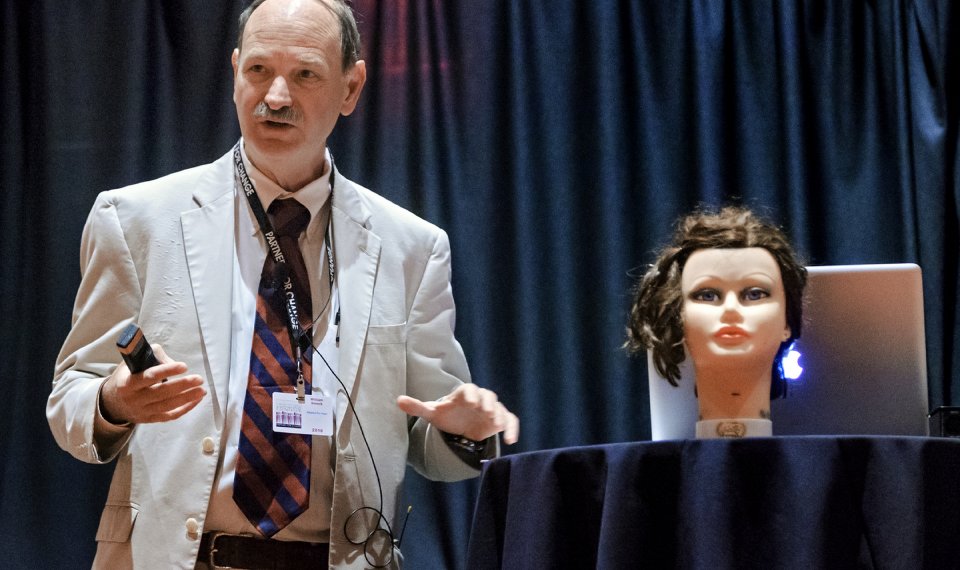The Oklahoman: Domestic, sexual violence issues examined at conference
By Darla Slipke
Published: September 17, 2018

Click here to read the story!
NORMAN — Dr. Bill Smock passed around a hand-held device and challenged everyone in the room to a grip test.
“Everybody in here is a potential killer,” he told the group, pausing.
Physical therapists use the medical instrument, called a hand dynamometer, to determine if patients are regaining strength in their hands. Smock, a forensic expert, uses it in court to demonstrate to juries just how much strength the human hand can create.
On this particular day, he used the device to illustrate a point about the dangers of strangulation to a group of Oklahomans.
Smock concluded his earlier statement: “Because it only takes 11 pounds to block your carotid artery.”
To block the jugular vein, it takes 4.4 pounds of pressure, Smock said. To block or collapse the windpipe, it takes 34 pounds of pressure — less than twice what it takes to open a can of soda.
“Every person in this room could do that,” Smock said. “It shows how easy it is for one human being to apply pressure to another human being’s neck and cause damage or kill them.”
‘The most dangerous men on the planet’
Smock, a police surgeon who directs the clinical forensic medicine program for the Louisville Metro Police Department, was among numerous presenters at the Partners for Change Conference on Domestic and Sexual Violence and Stalking. More than 750 victim advocates, law enforcement officers, prosecutors, legal aid attorneys, child welfare workers, counselors, facilitators of batterer intervention programs and others registered for the two-day event in Norman.
“The men who strangle women are the most dangerous men on the planet,” Smock told the group. “They’re the ones that will then shoot their spouse. They’re the ones that will shoot you, the police officer.”
If a person has been put in a strangulation hold, that person is 750 percent more likely to be killed if they stay in that relationship, he said.
In many cases where an officer is shot, there is a prior history of strangulation and domestic violence, Smock said.
A police chief in Idaho looked at his officer-involved shootings and found that 80 percent of suspects had a prior history of domestic violence and 30 percent had a prior history of strangling, just based on public records, Smock said. Another study done by a representative from the district attorney’s office in Riverside County, California, looked over a 20-year period and found that 50 percent of officers who were killed were killed by a criminal suspect with a history of strangulation assault against a woman in a prior relationship, Smock said.
He also said there is a connection between strangulation and mass shooters. He cited numerous examples of men who shot at police officers or carried out mass shootings who had a history of domestic violence or strangulation, including Robert Lewis Dear, who killed three people and wounded nine others at a Planned Parenthood clinic in Colorado Springs, Colorado, and Omar Mateen, the man who killed 49 people at Pulse nightclub in Orlando.
Strangulation can block air flow, blood flow or both, Smock said. Minimal pressure on the neck can cause serious injury, death, delayed death or long-term consequences, but victims who are strangled often have no visible injuries. Smock shared the story of a 36-year-old nurse who was strangled by her husband for the second time in their six-month marriage.
The woman went to a shelter, filed a police report and sought a restraining order. But since she had no marks on her neck and no trouble swallowing, she didn’t think she needed to visit the emergency room, Smock said.
He said that a domestic violence detective knew that even though the victim had no marks, she could have internal injuries that could kill her down the road. The detective convinced the woman to go to the hospital six days after she was strangled. It turned out, the woman had tears on both sides of her internal carotid arteries, Smock said, which is why when victims go to the hospital, it’s important for doctors to know what tests to order.
“If they do, they could save her life,” he said. “If not, they may send her home to stroke and die.”
He discussed how to build a nonfatal strangulation case for felony prosecution by using a multidisciplinary approach and asking specific questions to victims.
One of the most important things an investigator can do is ask questions in a trauma-informed way, Smock said. Instead of asking a victim if she was choked or strangled, investigators should ask if anyone put pressure on her neck.
Making things happen in Oklahoma
Smock said there is some magic happening in Oklahoma. He touted several initiatives and organizations based in the Sooner State, including Palomar, Oklahoma City’s family justice center, and a strangulation awareness training program earlier this year.
In May, more than 150 professionals attended the free, four-day training on strangulation awareness in Oklahoma City. Since then, prosecutors, advocates and judges have reported there’s been an increase in bail in strangulation assaults, as well as increased reporting and better investigations, Smock said. Hospitals have adopted an imaging protocol that is saving lives, he said.
“You have individuals, policies, people in place that are really making things happen,” he said.
Throughout the day Wednesday and Thursday, conference attendees had the opportunity to participate in their choice of dozens of workshops that addressed a variety of issues and topics.
One session discussed barriers that immigrant victims face. Another focused on how investigators can use digital evidence from social media platforms to strengthen cases and hold offenders accountable.
The conference is designed to provide resources and education and stretch the level of understanding of domestic violence and sexual assault response statewide, said Melissa Blanton, chief of the Victim Services Unit at the Oklahoma Attorney General’s Office.
“It’s been a great project by all the different partners to come together and say, ‘What are the emerging issues?'” Blanton said. “‘What’s happening in our state? What do we need to learn more about? How can we bring national trainers from other parts of the country that have talked about different issues to enhance the work that we all do?’ It’s really a collaborative effort.”
A victim’s story and a story closer to home
During a keynote address Thursday, Shanna Parker, a human trafficking survivor, shared her story. She was molested as a child and became a victim of trafficking.
“Unless you’ve experienced this, you cannot imagine how hard it is for a child to utter the words about what’s happening to their body,” she said. “You have to relive that to retell it.”
When she was 18 years old, her trafficker was given the death penalty for a double murder.
Time after time, Parker interacted with law enforcement and social service representatives, but they failed to help her. Parker shared the first police report she was on with her trafficker. The report detailed a violent situation. Officers who responded to the residence knew her age because it was noted in the report.
“No one recognized me as a 14-year-old little girl even though I weighed 100 pounds soaking wet,” she said. “I was recognized as a criminal, and I was treated as a criminal. And I was never offered any help.”
While sharing her story, Parker told the group to think about all the other Shanna’s who are right now wondering when their moment will come when someone will listen, when someone will make a difference.
“Children don’t know how to reach out,” she said. “Children need you to reach in to change this problem.”
Parker founded a nonprofit organization called Angels Go To Work and now works to help other youth and young adults. Earlier this week, she got a call about a pregnant victim in Oklahoma City who had fled her trafficker. As Parker worked to try to help the victim, she said she found a lot of gaps that need to be filled in Oklahoma.
“We met her needs, but externally, and we want to be able to do that from within Oklahoma,” she said.


